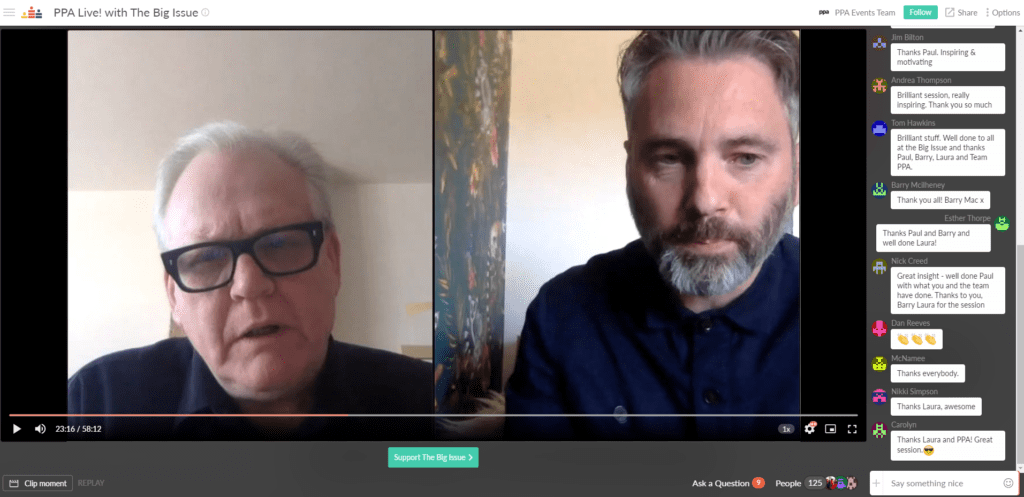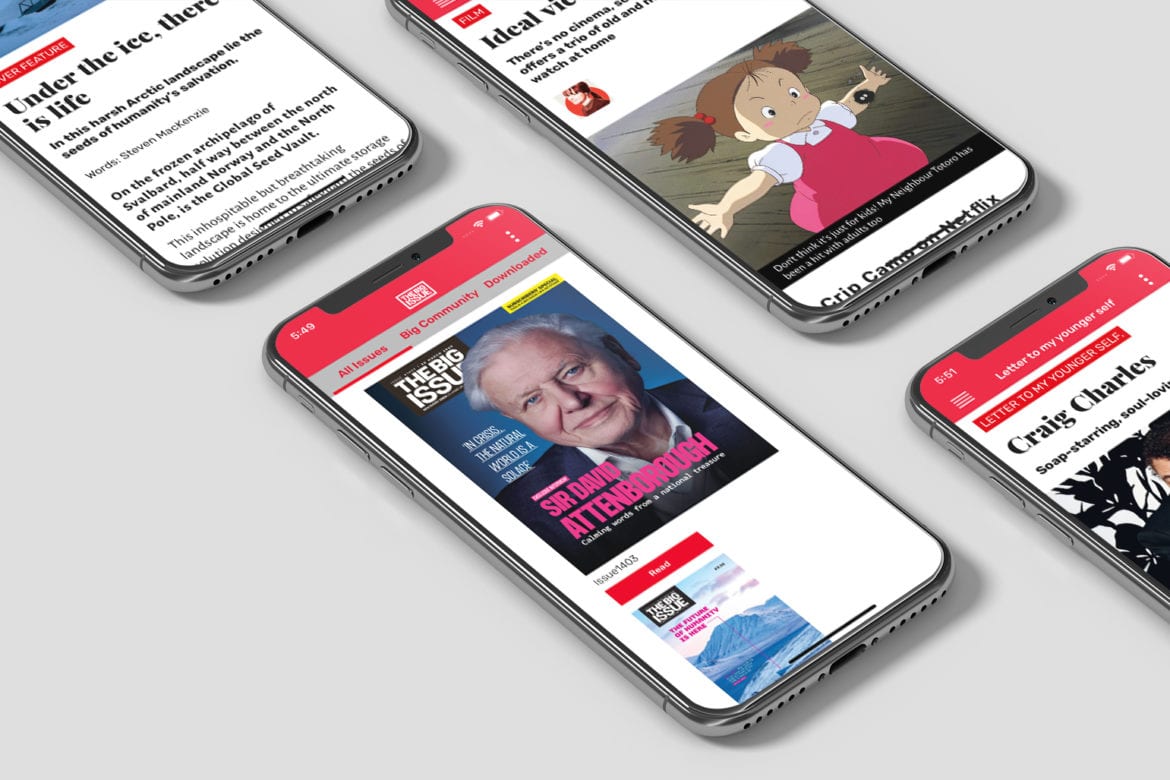|
Getting your Trinity Audio player ready...
|
Coronavirus has touched every aspect of the publishing industry, and many organisations have had to upend their workflows and operations in order to continue. But what happens when a core part of a publisher’s distribution network vanishes?
This is a situation that the Big Issue team have had to face over the past few weeks, and because of how their distribution model works, they have had to adapt everything about how the business works. The Big Issue is a weekly magazine sold by homeless people, or those at risk of homelessness, as a way to earn a living and help them out of poverty.
Big Issue Editor Paul McNamee discussed how the publication has had to swiftly adapt in a virtual interview with Barry McIlheney yesterday, as part of the PPA’s Live series. The session can be watched on demand here.

Preparing for change
As the end of January approached, McNamee and the team could see the potential impact of coronavirus on the horizon, as it began to affect life beyond China. “We knew something was coming, and we knew we were going to have to make some tough decisions,” he said.
But as the threat of lockdown approached in the UK, McNamee knew they would have to move swiftly to keep their vendors safe. “That Friday [19th March, 3 days before the government announced a lockdown] we decided to take vendors off the street immediately. A lot of our vendors have underlying health problems, so we knew that it wasn’t safe for them.”
The government had told the Big Issue that they were going to start moving rough sleepers into hotels and other accommodation, but that would still make life incredibly challenging for them. “Everything changed in that moment,” said McNamee. “We had to think very quickly about what we were going to do, because clearly, even if people were being put in supported accomodation, they were going to have to get some money.”
Not having vendors in the street – or anyone else in the street to sell the magazine to – put the Big Issue in a uniquely challenging position. The publisher has deliberately shied away from subscription sales and a significant digital presence in the past, as the vendor distribution is vital to their mission of helping people out of poverty.
“The whole raison d’etre of the Big Issue is to get people who are right on the margins a means to work themselves out of poverty,” McNamee explained. “To do that, they buy the magazine and they sell it on the street. And when you don’t have that means, that place to do it, you think, how on earth are we going to support these people, and maintain a presence as a magazine?”
In those moments you either collapse, or you stand up, you think, right, we’re going to do something.
With vendors no longer safe on the streets but still in need, the team had to undergo a rapid transformation. The publisher doesn’t shore up large cash reserves, preferring instead to reinvest in making the product – and therefore the sellers – more successful.
“Luckily within the Big Issue, we have a host of really brilliant people who very quickly came up with some ideas,” McNamee said.
Introducing subscriptions
The first stream the Big Issue team got up and running within a matter of weeks was an option to subscribe. “Unlike other publications, we didn’t have a strong subscription base, so we had to put a call out to readers to come in and help us,” McNamee explained. “We offered a three month subscription for £33, the magazine is delivered to your house, and we split the net proceeds with the vendors.”
Initially the subscription was just a three month option as that’s how long the team through the coronavirus situation would go on for, but a 6 month option has now been added.
Setting a goal for subscriptions was a challenge, given their starting point of almost nothing. “We had 60,000 in mind as the number of subscriptions we wanted, but we’ve got no way to get there, it’s just a desire,” explained McNamee. “We had no way of promoting it, but good people were helping to do it online, and we were drawing on all our contacts and doing everything we could.”
The publisher also began to see a rise in people wanting to make one-off donations, so set up an appeal fund to allow the public to contribute. As with normal magazine sales, 50% of proceeds from these initiatives will go straight to the vendors.
Selling in supermarkets
Once the subscription option was up and running, the publisher began looking at other ways to help distribution. This led to speedy deals with Sainsburys, McColls, The Co-op and other supermarkets to sell the Big Issue in store for the first time.
McNamee credits the respect the Big Issue has with being able to sort temporary arrangements like this with major supermarkets so quickly. “We’ve had a lot of really great support from the outset, and a lot of people who like and respect the organisation,” he explained.
“It’s been incredible and really moving to see people start to get their subscriptions through the post, or people taking pictures of the magazine in the supermarket, and all of a sudden from the depths of crisis, there’s this new burgeoning possibility.
Quick app launches
The most recent launch has been the Big Issue app, released in partnership with publishing platform Pugpig late last week. This again is to help maximise sales of issues, but also offers access to “The Big Community”, a curated channel ‘providing hope through positive and inspiring stories’, focused on the people and businesses coming together to support homeless people.
Fitness coach Joe Wicks – of P.E. with Joe and The Body Coach fame – is the cover start for the first issue, and has thrown his support behind the app, where the weekly magazine can be purchased for £2.99.
“Pugpig helped us build an app from scratch and develop the content on it, and then get us quickly into the app stores,” explained McNamee. “We’ll develop it as we go, because it’s not perfect by any means, but it’s just another means to get the magazine out to people and get income so that we can then disperse and distribute again.”
However, this has meant that the already small team have had a lot land on their plates, as well as getting used to producing the magazine remotely. “We’re now not just thinking about print; we’re thinking about an app, subscriptions…we’ve had to increase the body of work that people are doing, and try and be very organised,” McNamee said.
Distributing funds
Despite the Big Issue’s lack of existing digital or subscription infrastructure, the organisation was very forward-thinking on enabling digital payments last year, which has helped a great deal when getting funds to vendors during the crisis.
“Part of the reason why we’re successful with doing this now is that, going back a little further with the move to cashless payments, a lot of vendors were brought in [to a system] where they were able to bank, and therefore they have telephones, and we can move money into their accounts quite quickly.”
Not all vendors are on this scheme, but McNamee says it’s a growing number, which has helped their outreach efforts should a vendor end up really stuck over the next few weeks. Most vendors have now been contacted by distribution staff, or have got in touch themselves, and shopping vouchers are also being distributed at a socially safe distance to other vendors in need.
Life after coronavirus
The Big Issue’s transformation has happened in less than a month, but this agility will have to continue for some time. “When social distancing eases, will there be an instant return for vendors?” speculated McNamee. “Probably not, so we’re going to have to think creatively about what the Big Issue looks like in three months, six months, in a year’s time.”
It will never again I think be wholly sold on the streets. We will have to find different ways to help those who need us, we’ll have to find a combination of digital and street, and any other ways to do it.
McNamee was keen to emphasise that none of these measures will look the same after lockdown, for example selling in supermarkets will not be a viable option as the magazine currently has a deal for good racking rates, and the emphasis will need to return to the vendors themselves. Instead, the publisher will look at ways these channels can be used to amplify the message.
“One thing we talked about that may or may not happen, is if there are areas in far flung parts of Britain where there is poverty but there isn’t a Big Issue vendor, perhaps shops can carry a Big Issue so we can still use the impact of the sale and have the money reinvested to beat poverty in that area,” he hypothesised.
“So then we start to become a slightly different organisation, a slightly different magazine. These are conversations we’re being forced to have, but it’s alright. I’d rather we weren’t in these circumstances, but because we are, you either stand up or you fold.”
There will also be serious considerations about how to help vendors get back to ‘normal’, as concerns around handing out magazines and social contact will likely be around for some time.
All this will leave the Big Issue as an organisation asking itself some difficult questions. “The great irony is for the 29 years that the Big Issue has been in existence, we’ve said, we’re a hand up, not a handout. That’s been our whole ethos,” McNamee surmised. “But for a little while, we have to be a handout.”
Learn more about supporting the Big Issue here.



